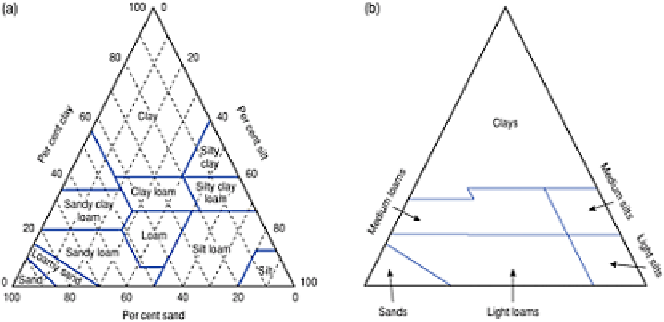Environmental Engineering Reference
In-Depth Information
Various systems have been used to classify the texture of soils in this way. One of the
most commonly used is the USDA-FAO texture triangle shown in Figure 18.1a, giving
the names of soils according to different proportions of sand, silt and clay. Figure 18.1b
shows the broad grouping of soils into the six most commonly encountered soil textures:
sand, light loam, light silt, medium loam, medium silt and clay. The amount of sand, silt
or clay in soil samples can be estimated approximately in the field by the simple
technique of moistening a handful of soil, working it between the fingers and determining
the texture by the 'feel' of the moist soil. Clay is very sticky and hard to work, silt is less
sticky but very smooth and greasy. A sandy soil has very little stickiness but a distinctly
gritty feel. Accurate determinations using the principles of sedimentation can be
performed in the laboratory using a hydrometer or a pipette.
Figure 18.1
(a) The soil textural triangle according to the US
Department of Agriculture and UN Food and Agriculture
Organization; (b) broad groups of textural classes.
Texture or particle size influences many chemical, physical and biological properties of
soil. Larger particles have larger pores between them and therefore allow more rapid
infiltration and
drainage
of water. Finer particles have finer capillary pores which, in
contrast, hold water in the soil and thus improve the soil's
water
-
holding capacity
. Thus
coarse-textured soils are quickly drained of rainfall and are not able to hold much water
for plant growth. They are 'droughty' soils, and lack of available water can be a
limitation on their productivity and choice of crops. However, because the solid phase
has a much lower heat capacity than water, coarse-textured soils heat up much more
rapidly in spring, and thus have longer growing seasons. In contrast, fine-textured clays
have greater water-holding capacities, and thus show fewer symptoms of drought. Indeed,
the farming problem here is often to remove excess water by artificial drainage in order
to improve soil aeration. Because plant roots need oxygen for respiration, soil
waterlogging can be a serious limitation. Equally, wet clay soils will be slow to heat up,
given their high heat capacities. Thus soil texture is important in water capacity and
movement, soil temperature and aeration (see Chapter 8).

